
This article deals with the interchangeable viewfinders of Nikon's first five professional F-Models, produced between 1959 and 2004.
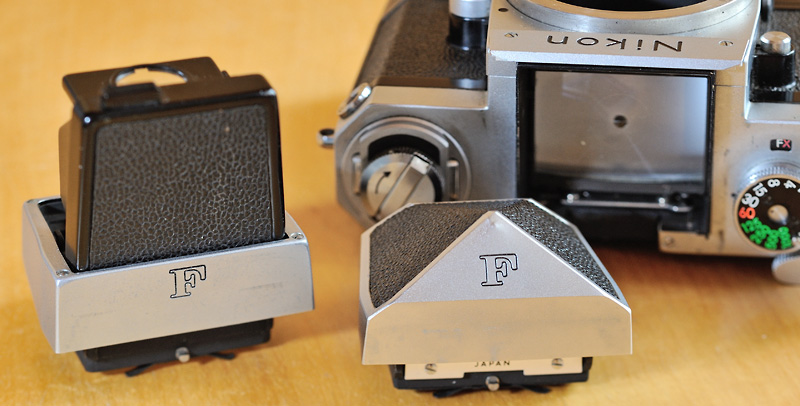
|
Back in 1959, the Nikon F was introduced together with the waist-level finder and the eye-level finder.
The eye-level finder is a prism finder we all know very well, because our DLSRs have such a prism built in. In the times of the F it was just called the eye-level finder. Later Nikon introduced a numbering system for their accessories. The corresponding eye-level finder for the F2 was called DE-1. For the F3 it was the DE-2. The later introduced "HigheyePoint Finder" or short "HP-Finder" for the F3 was named DE-3. The latter has a slightly lower magnification, but it is easier to view the complete image, especially for wearers of glasses. Until today, HP-finders are a Nikon standard, especially in the professional and semi-professional models.
In the 60s Nikon began to produce "Photomic" finders for the F. That are huge eye-level finders with integrated electronics for metering. If you are interested in the F-Mount's history of exposure metering I recommend to read my article The wild early years. Beginning with the F2 (introduced in 1971) Nikon used the letters "DP" for the Photomic finders.
Back to the roots! The waist-level finder is the simplest finder one can build: it is just a foldable hood. What you see is the image on the focussing screen. With this finder you can shoot unnoticed while holding the camera at waist level! Or you hold the camera above yourself if there is something in the way. Moreover, it is a great tool for low angle shots. For critical focussing, a simple swing-up loupe is integrated, which allows you to see the complete image in a 5x magnification.

|
|
F waist-level finder wilth fold-up loupe. |
Unfortunately, this finder has a design-related problem: what you see is not what you get!
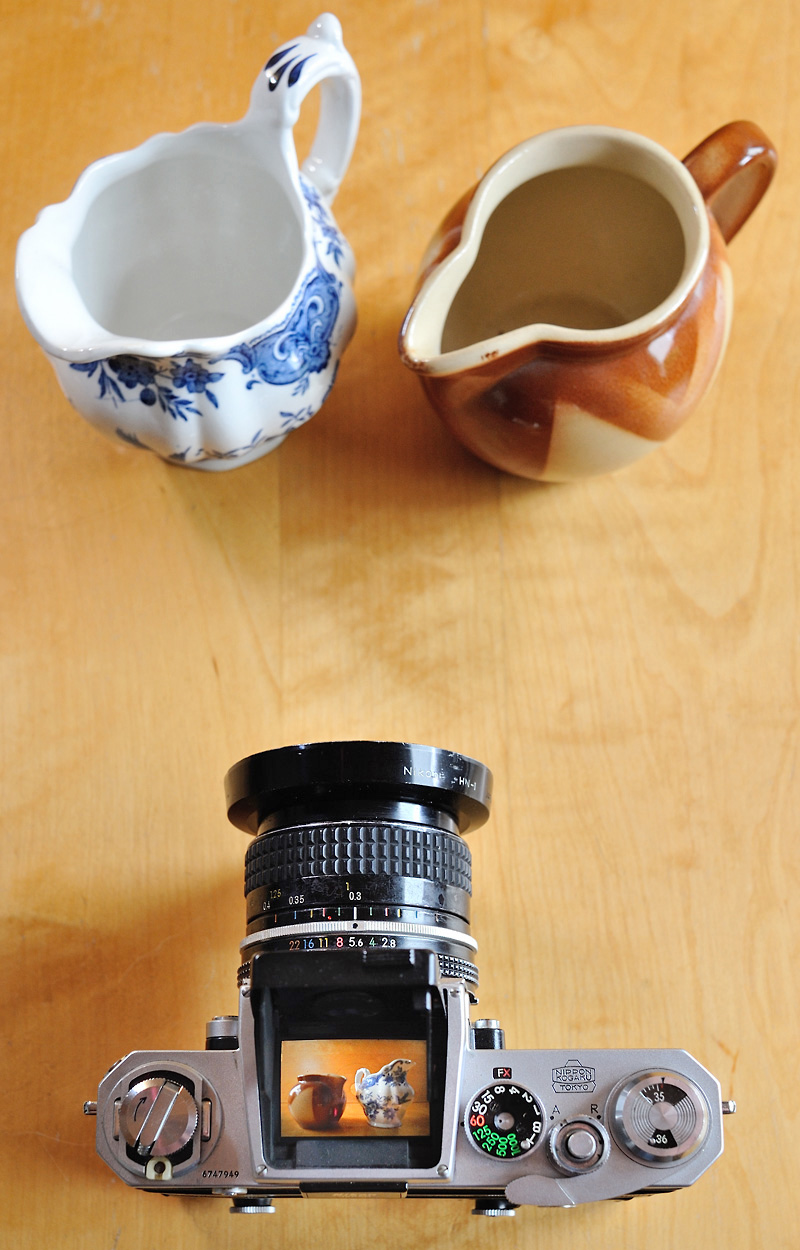
|
|
Nikon F with waist-level finder (original finder image, no composition). |
It is not that easy to work with such a mirror-inverted image in the finder! Besides, it complicates image composition, because most people do not experience an image and and its mirrored counterpart to be equivalent.
Starting with the introduction of the F2, Nikon used the letters "DW" for their waist-level finders, F2: DW-1, F3: DW-3, F4: DW-20, F5: DW-30.
A similar type of finder is the "Magnifying Finder". It works like a waist-level finder with a permanently folded-up loupe. The optics consists of more elements and delivers better quality. The magnification is 6x. Nikon named these finders also "DW" - F2: DW-2, F3: DW-4, F4: DW-21, F5: DW-31.
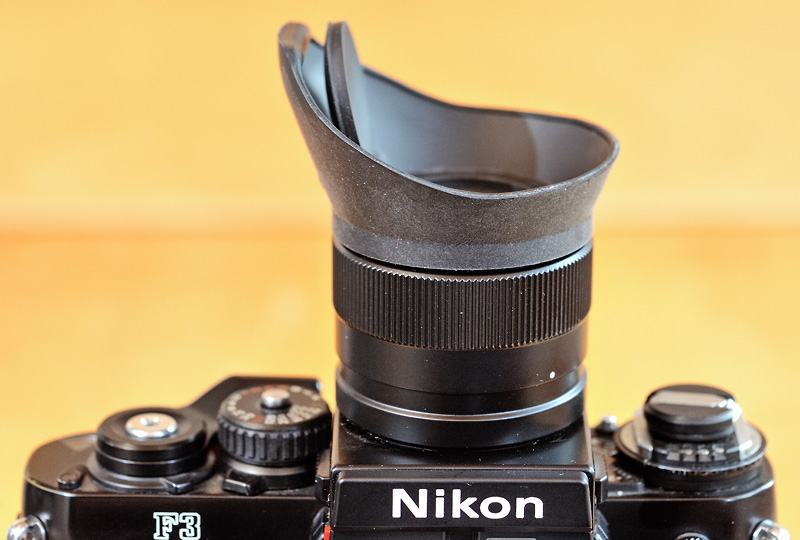
|
|
Nikon F3 with DW-4. |
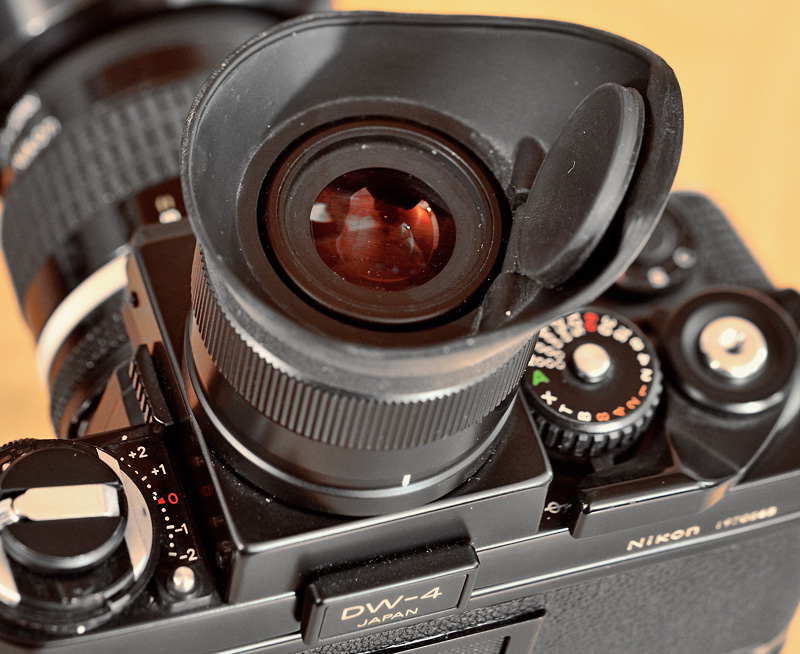
|
I used the combination F3 plus DW-4 in the pre-digital era for macro work. A magnifying finder is great for precise focussing. Moreover, the finder can be used on its own as a loupe (but pay attention not to touch the subject).
The fourth and last type of Nikon's finders is the so called "Action Finder". It is a prism finder with a really large eyepiece:
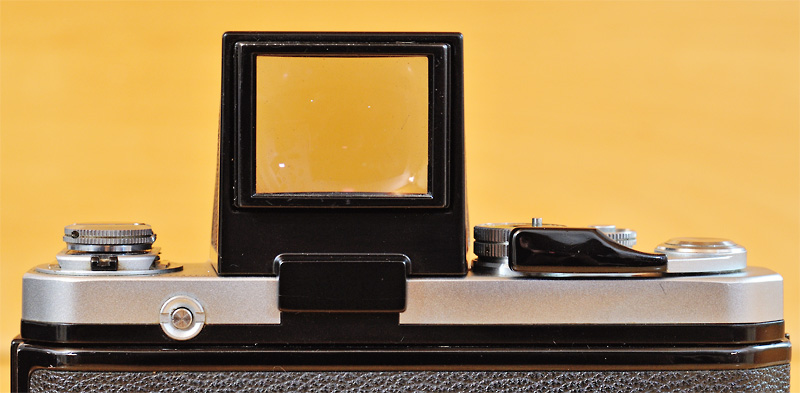
|
|
Nikon F2 with action finder DA-1. |
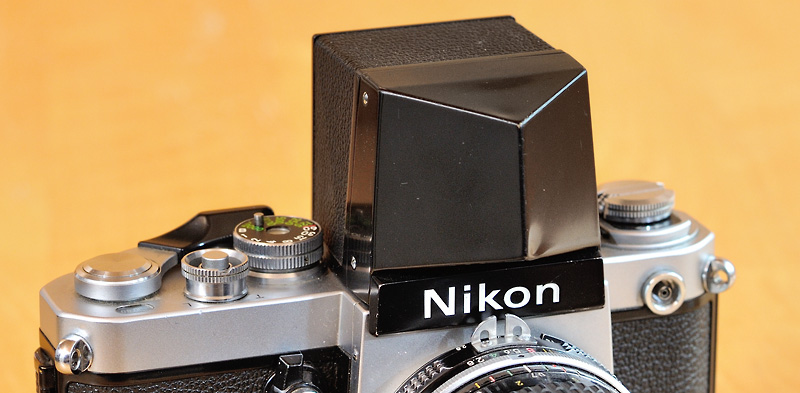
|
It allows viewing the complete viewfinder image a few centimetres away from the eyepiece. This is a great finder if the camera is used in an underwater housing or if the photographer must wear safety glasses.
This type of finder was not available for the Nikon F. The first one was the DA-1 for the F2. But with the help of a screwdriver the DA-1 is also usable on the F, see next chapter. The action finder for the F3 is the DA-2, for the F4 the DA-20 and for the F5 the DA-30.
The F and F2 cameras share the same basic mechanics in the viewfinder mount:
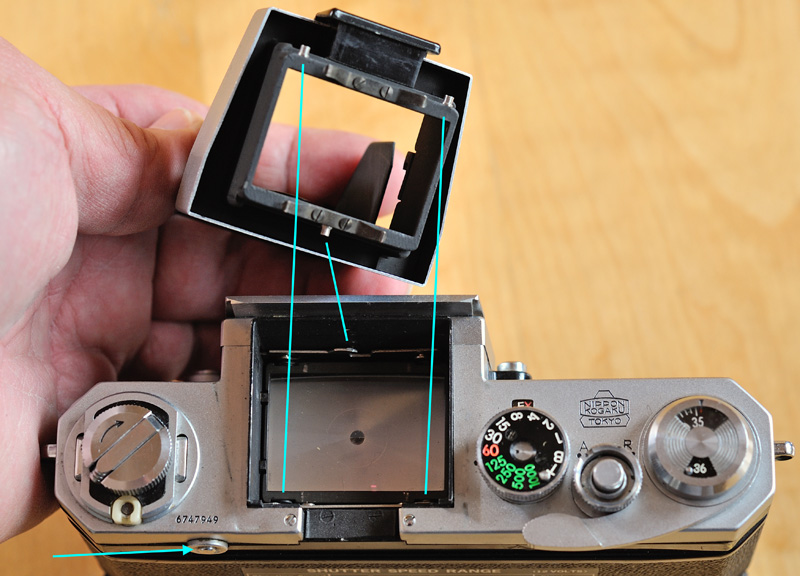
|
|
The finder has three pins and the camera has corresponding clamps. The clamps have a spring mechanism - you just have to press the finder onto the body for fixing it. For releasing the finder you have to press the little button below the serial number (see arrow). |
It sounds easy, but my experience after having had several different F and F2 bodies in my hands is not that great. The finder-locking mechanism of the F/F2 does not exactly work smoothly. For some camera-finder combinations you need a lot of force for mounting. Maybe, you need a pencil or something like that for pressing the finder release button deeply in order to get the finder unlocked. Or you just press it a bit and with a little jump the finder signals it has been released. But we have to keep in mind that we are speaking about well-used and 50-year-old equipment.
Basically, the finders without exposure metering (not the Photomic finders!) are interchangeable between F and F2:
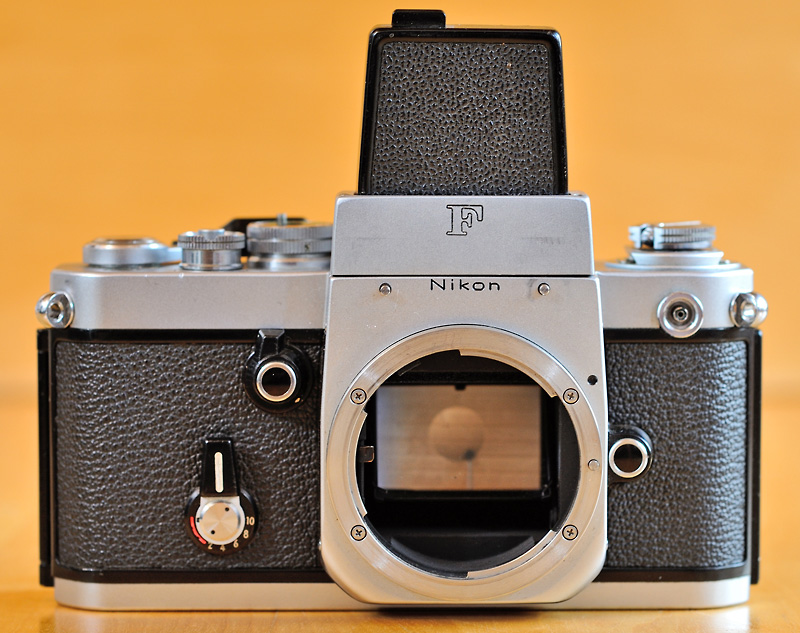
|
|
Using an F finder on an F2 body means you have one Nikon logo too little. But everything works fine. Using an F2 finder on an F body means you have one Nikon logo too much. After removing the name plate there is no problem. |
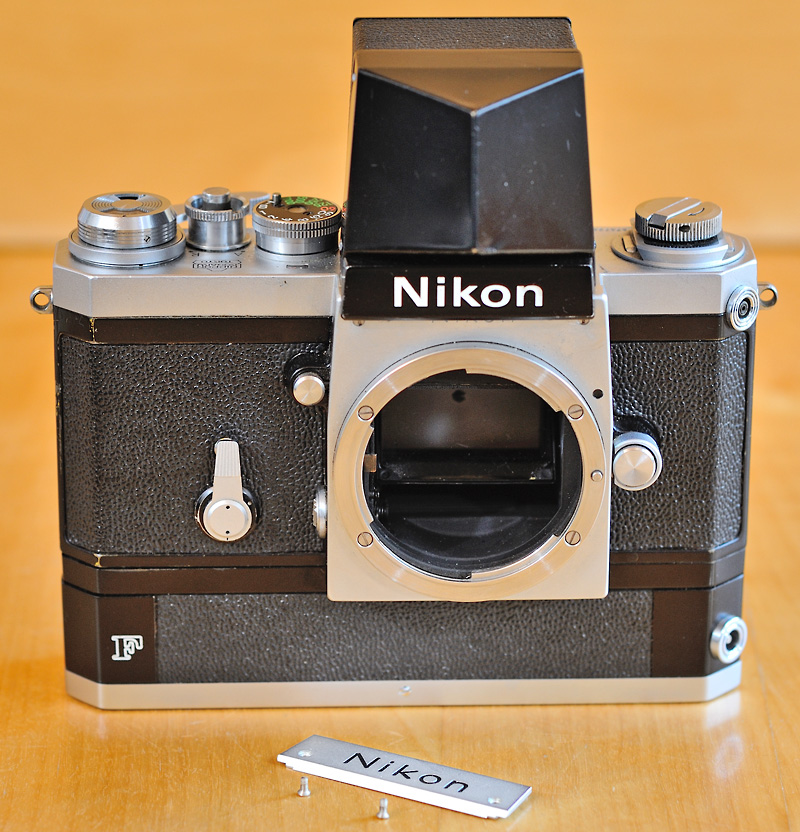
|
Also, the focussing screens are exchangeable between the F and the F2. More information on that can be found in my article Upgrading two old mechanics.
The Photomic finders are much bigger and heavier than the non-metering finders. Nevertheless, Nikon only used the basic locking mechanism described above for the early Photomics. If the frontside of the finder gets a hit onto the side or onto the bottom, a critical leverage results.
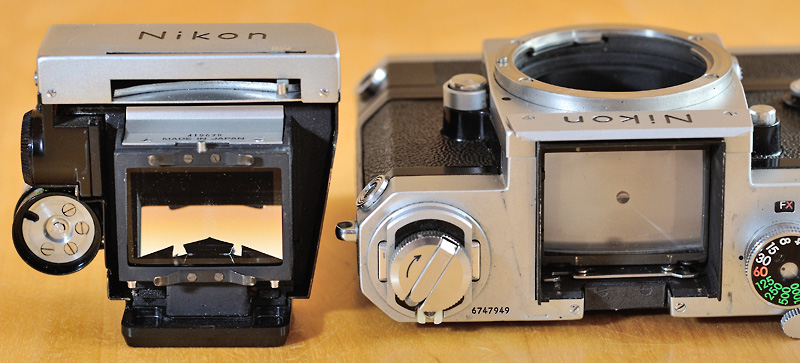
|
|
Photomic TN finder, introduced 1967. |
In the latest Photomic for the F (the "Photomic FTN") Nikon used a second, independent locking mechanism. The finder has two spring-mounted clamps which grab under the name plate of the camera. At the side of the finder there is a release lever for that mechanism.
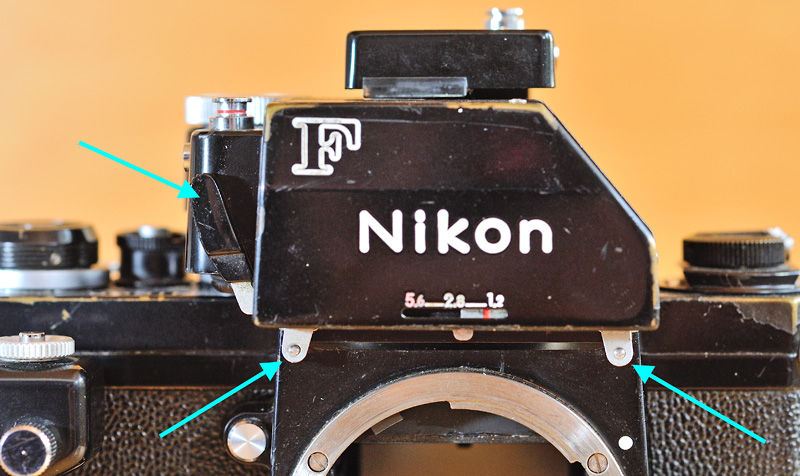
|
|
Photomic FTN finder, introduced 1968. |
This conjunction is sturdy. But exchanging the finder is more complicated due to the two locking mechanisms.
If you have bought an F body and an FTN finder separately, the following problem can occur:
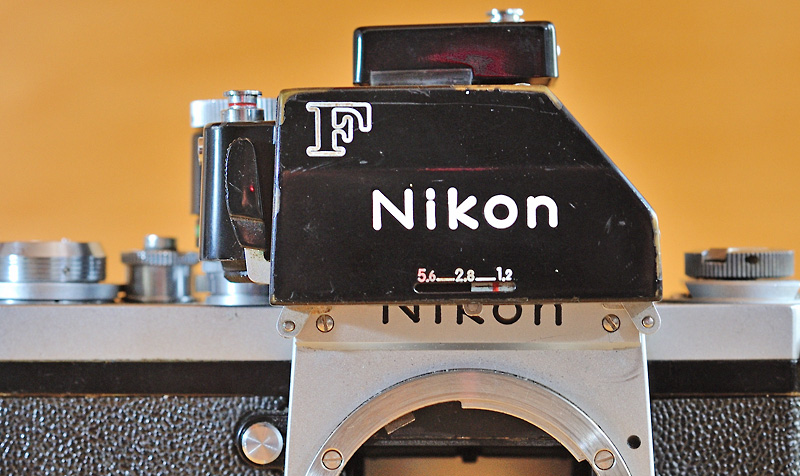
|
|
The FTN finder is not mountable because the clamps don't spread wide enough for getting under the name plate! |
The reason is Nikon changed the shape of the F's name plate slightly for the FTN finder! Therefore you have this problem if you try to mount the FTN on an older camera body. You just have to remove the plate and give it the new shape with a good file!
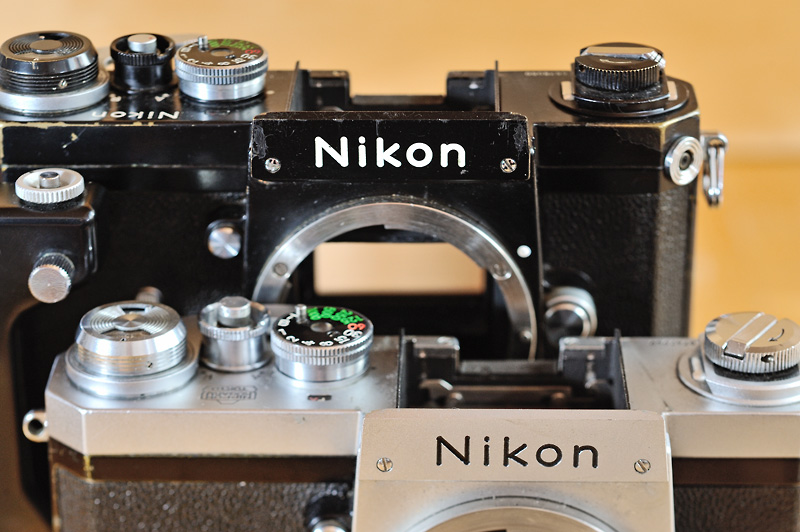
|
|
Slightly different shape of the name plate: the black body is newer. |
The Photomic finders for the F2 got also a second - but improved - locking mechanism:
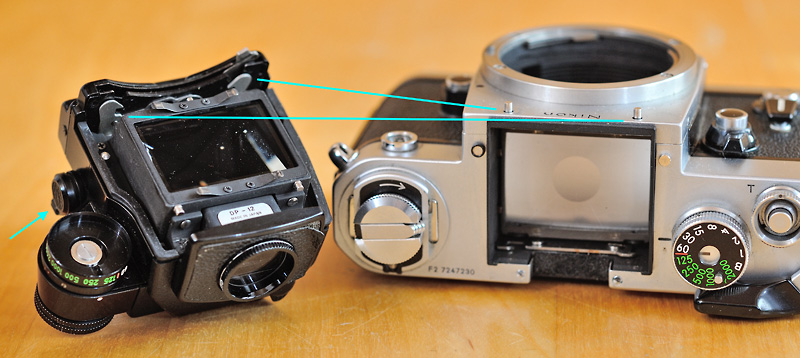
|
|
Photomic finder DP-12, introduced 1977. Every Photomic finder for the F2 shares this locking mechanism. For unlocking you have to press and rotate the lever (see arrow). |
In contrast to the F the battery compartment is located in the camera body and no longer in the finder. The winding lever has got an "on"-Position at about 30 degrees. The Photomic gets power only when it is switched on (you can see the contacts for the power supply in the above image).
Another improvement is the flash-ready indicator in the finder (with suitable Speedlights). For that purpose the Photomics and the DE-1 have got a direct contact for the Speedlight on their side.
Important for all F and F2 Photomic finders: if you want to mount a Photomic finder remove the lens first! The reason is that the coupling for the lens' aperture ring is part of the photomic finder. The later F models do not have this problem, they have the coupling integrated in the camera body.
The F3 - introduced in 1980 - has got the easiest-to-handle finder exchanging ever!
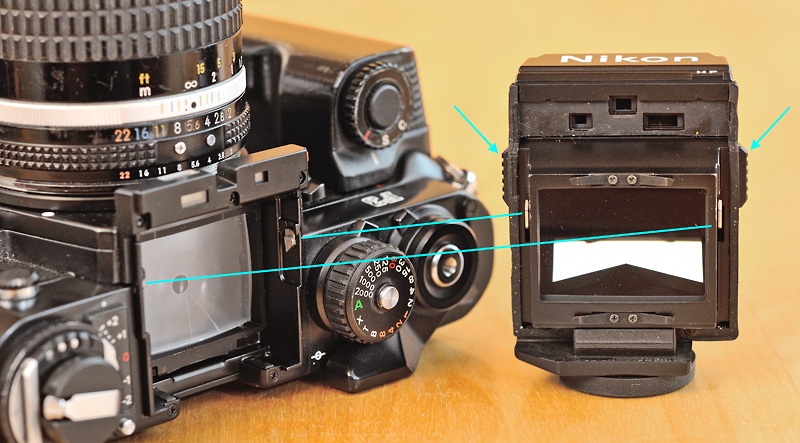
|
|
Nikon F3 and DE-3 finder. One clamp on each side with a slider for unlocking. That's it! It's sturdy and it works very smoothly. |
The groundbreaking fact of the F3 is that the exposure metering is located inside the camera body. Thus, metering is available with each finder (and also without). The finders do not contain any electronics (not counting some special versions of the F3). It's no longer necessary to make exposure corrections depending on the focussing screen.
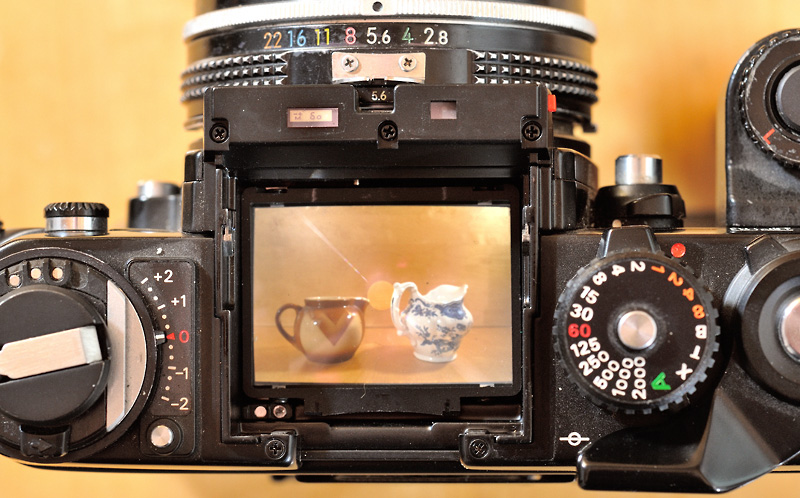
|
|
Nikon F3 without finder - everything works! Above the focussing screen on the left the metering window, in the middle the hole for the aperture direct readout (ADR) and on the right the window with the flash-ready indicator. |
I will not mention the numerous special models of the F3 Nikon offered. I make only one exception: the F3AF, the first professional AF camera, placed on the market in 1983. The camera comes with the really huge DX-1 finder, that contains the AF electronics including battery. The special lenses for the F3AF have got an integrated AF motor (see my article Understanding the F-Mount: AF lenses with an aperture ring). Thus, AF works without the camera body - the finder and the lens manage it! The only speciality of the F3AF body are electrical contacts within the F-Mount and within the finder mount to ensure finder and lens can communicate.
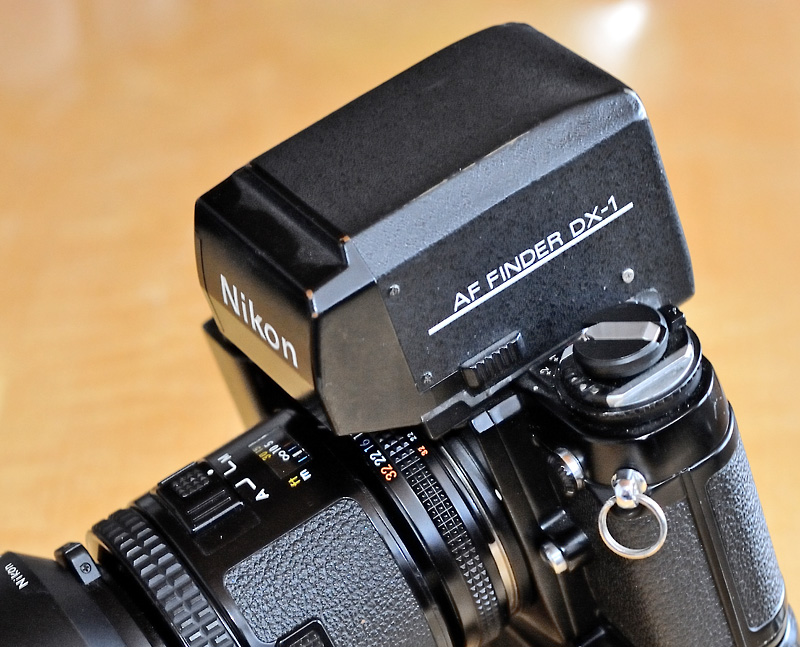
|
|
The huge DX-1 finder of the F3AF. |
The F4 - introduced in 1988 - broke a tradition!
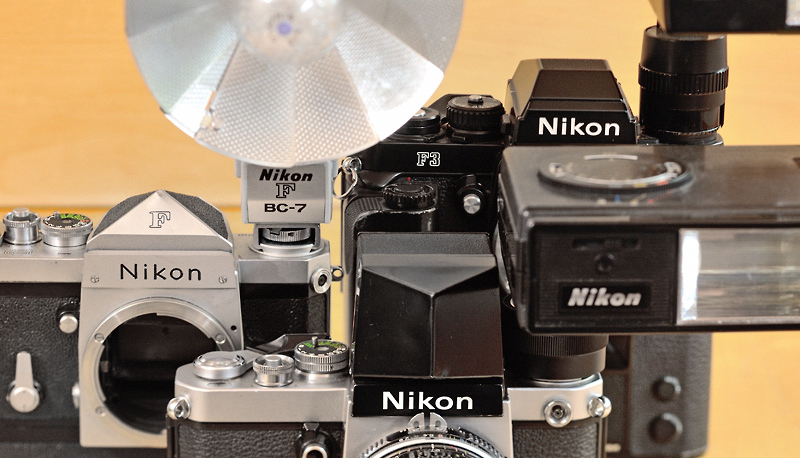
|
|
The flash mount of the former F models was located on top of the rewinding crank. The F4 (and also the F5) has a hot shoe on the top of the prism finder. |
With a speedlight on top of the finder the connection between camera and finder must be extra stable! Nikon used a rail technique to ensure it. The finder must be pulled from the camera's backside into its position. It is a bit fiddly...
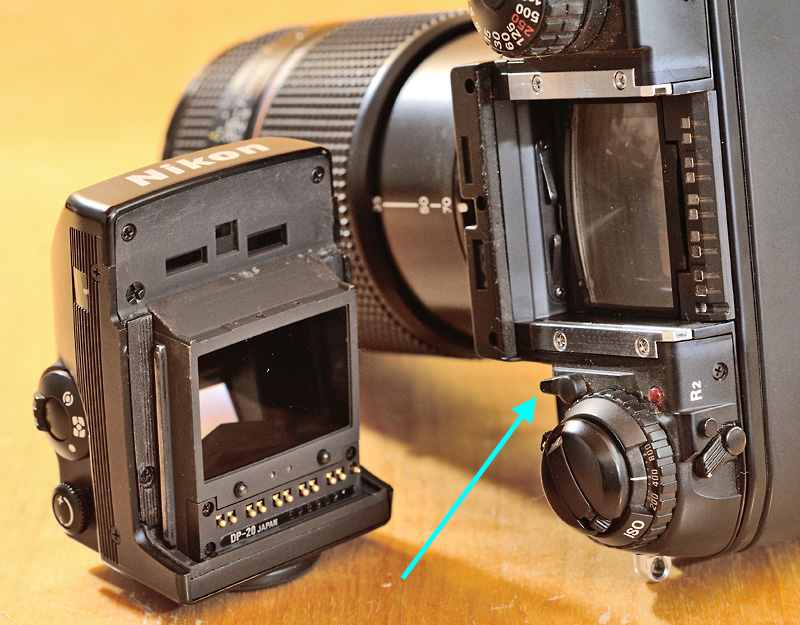
|
|
The rails of the F4 and the DP-20 finder. Unlocking with a lever on the camera, see arrow. |
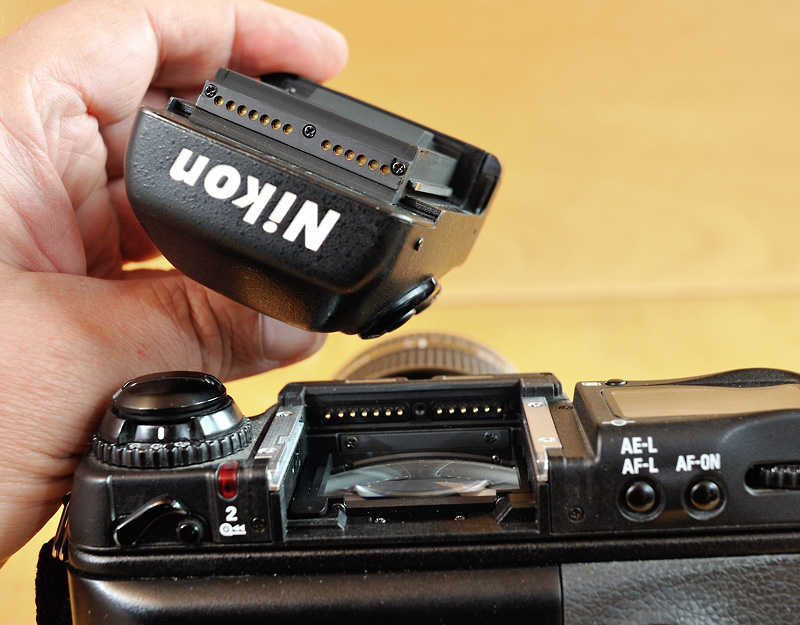
|
|
The rails of the F5 and the DP-30 finder. The finder mounts of the F4 and the F5 are incompatible. Below: unlocking with a button on the backside of the finder, see arrow. |
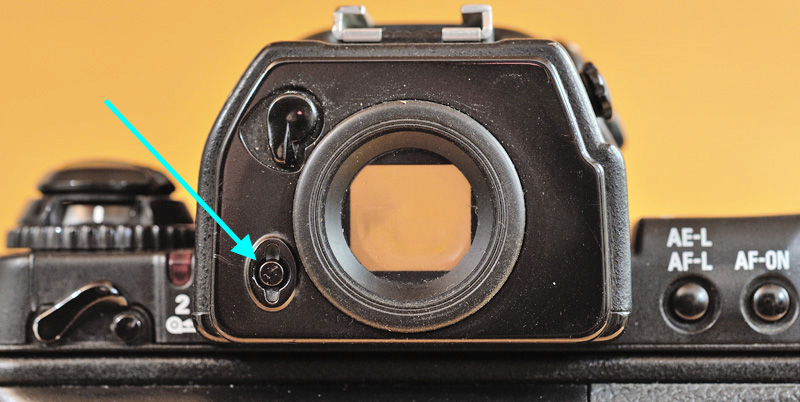
|
|
|
The action finders of F4 and F5 have got a hot shoe, too. But how to flash with a waist-level or magnifying finder? These finders have got a port for connecting a Speedlight via the SC-24 cable:
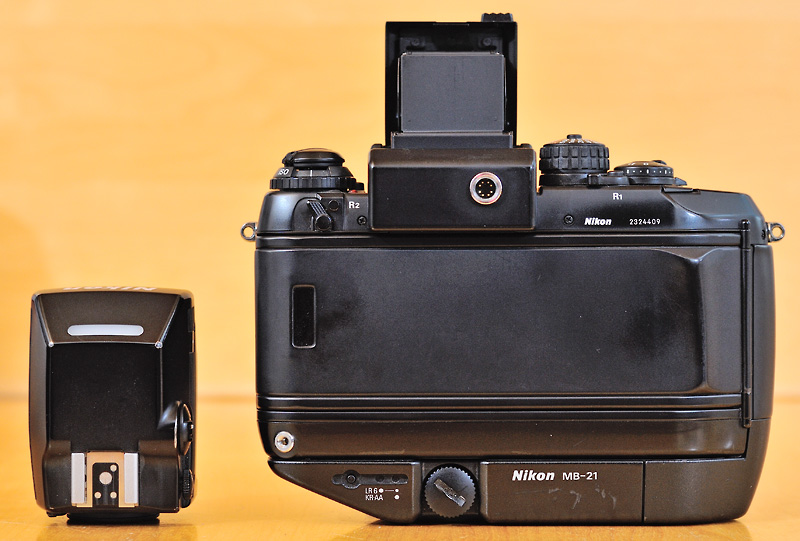
|
|
Nikon F4s with mounted DW-20. On the left the DP-20. |
Good news: the F4 and the F5 have inherited the in-body exposure metering from the F3. Bad news: while the F3 offers center-weighted metering, the newer bodies offer spot metering. In my opinion that restricts the usability of the finders without metering (waist-level and magnifying finder). But Nikon had good reason for it: the AF system is integrated in the camera body. Please remember: Nikon's first professional AF camera - the F3AF - had the AF electronics in the finder. The AF systems of F4 and F5 are available with each finder, which is great! The AF sensors are also used for exposure metering, but only allow spot metering. You cannot have everything!
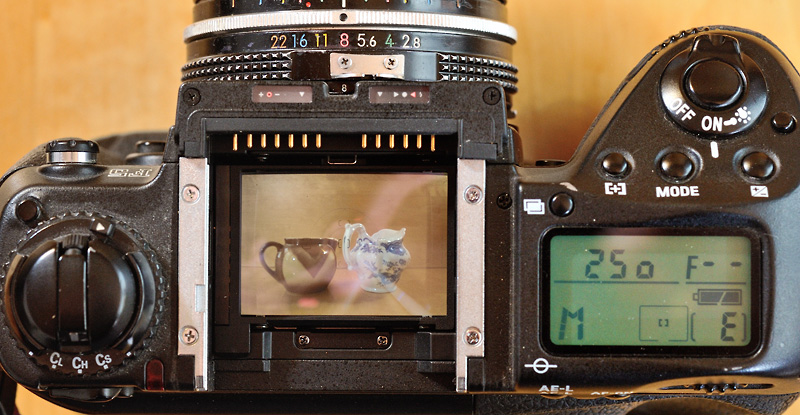
|
|
Even the F5 works without a finder. But only spot metering is available. Above the focussing screen on the left the metering window, in the middle the hole for ADR and on the right the window with the focus and flash-ready indicators. |
The action finder DA-20 for the F4 has electronics inside for offering center-weighted metering (it's a Photomic ;). The DA-30 additionally offers a simple form of matrix metering. Therefore these finders are more expensive and huger than their predecessors.
The F5 was placed on the market in 1996 and in 2004 it was replaced by the F6, the last F model. The F6 does not have interchangeable finders.
If you want to experiment with the different finders I recommend to do it with the F3! It is a well-engineered camera system. No wonder Nikon has produced it for over 20 years!
With the F and F2 cameras you need an external meter unless you use a Photomic finder. The F3 offers center-weighted metering with every finder. For the waist-level or magnifying finder that is better than the spot metering the newer F4 and F5 offers. The action finders DA-20 and DA-30 are much more expensive than the F3's DA-2, because they contain metering electronics. Only the DA-30 offers a little bit more with its matrix metering.
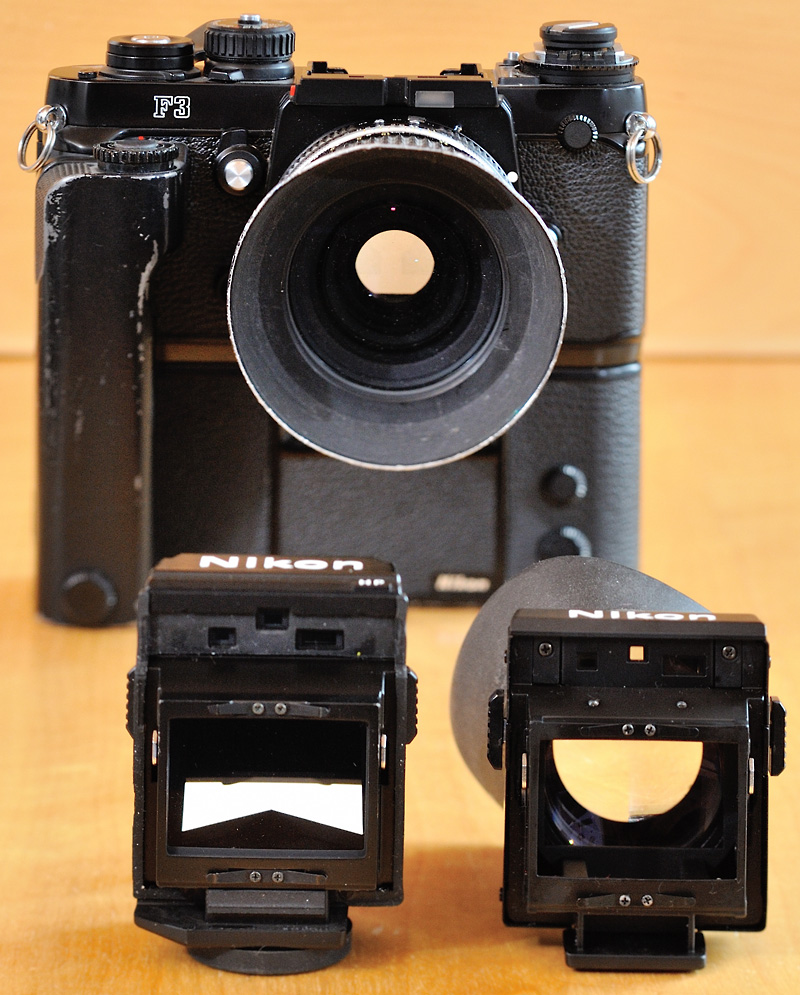
|
|
When it comes to the implementation of the interchangeable finders, my favourite is the F3! |
No. Not in the classic form of the F models.
Yes, in a modern way! I can switch my DSLR into live view. Then the display becomes a type of action finder. If my camera has a tilting display, it is like looking onto an F model without a finder. That is great. Unless you are in the field in bright sunlight! In such situations the display is useless, or you must use a black cloth like photographers did 100 years ago. In such situations I am happy to have the right-angle finder DR-3 in my bag!
How about a built-in, foldable EVF for live view? If I do not need cables in the field, it would also be acceptable as an accessory. Hey Nikon, that would be a kick for the D5!